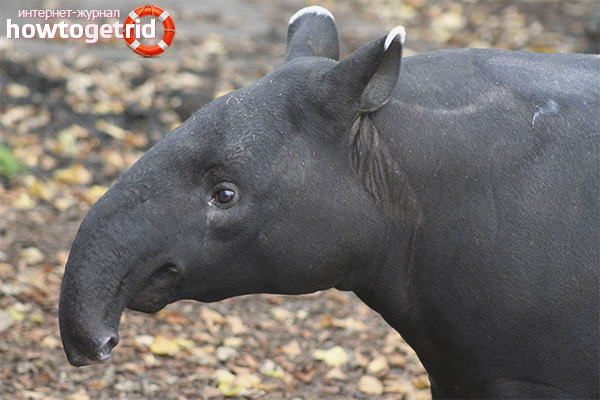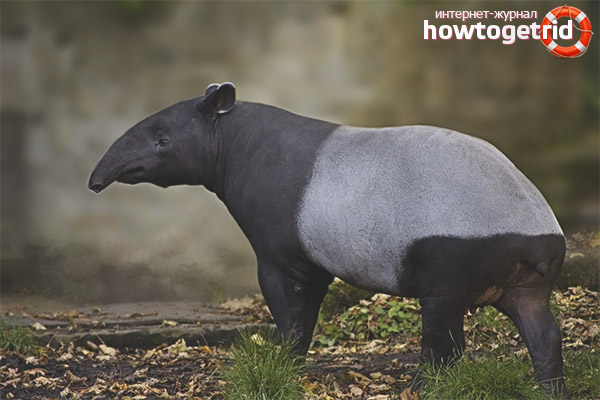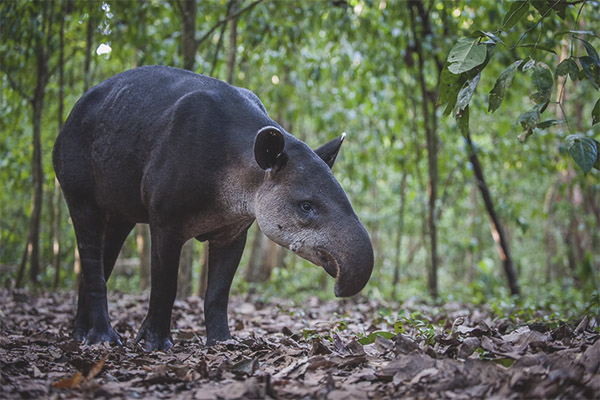The content of the article
Tapirs belong to the detachment of solids, and most of all outwardly they resemble pigs. Nevertheless, tapir distinguishes one significant distinctive feature, which is the large trunk used by this animal to capture food and sniff the surrounding space.
Features of appearance and behavior
In fact, the trunk is also the upper lip, although tapirs are somewhat similar to a mixture of an elephant and a pig, they are far from these families and zoologists are separated into a separate family of tapirs.
Previously, these animals were quite common, but now have a very narrow habitat, and they live in southeast Asia and South America. Prefer water and wet areas with an abundance of vegetation.
They have three toes on their hind legs, and their front legs have four.An interesting feature of this animal is its thick skin, which helps them to live in the rather harsh conditions of the jungle. By the way, it was the thick skin that gave the name to this beast, since in the dialect of the Brazilian aborigines, tapir is translated as thick, here they used an indication specifically on the thick skin
Tapirs live for the most part in the vicinity of reservoirs, as they love to swim. Most of the time they are alone and unite only for the breeding season.
Tapirs are quite demanding on the quality of water and prefer only clean water. They spend most of their time in reservoirs. In addition to swimming on the surface, they also know how to dive perfectly and swim underwater.
Despite the relatively compact size (up to two meters in length and about 50-70 centimeters in height), tapirs have significant body weight. Adult animals can reach up to 300 kilograms of weight, although younger individuals weigh, of course, less.
Interesting Facts
When tapirs dive under water, they are often stuck around with small fish that help these animals get rid of parasites.
The existence of tapirs is full of dangers, as they have a huge number of natural enemies - on the ground and in the water. In particular, on the surface of land, tapirs prefer to savor anaconda, jaguars, tigers, bears, and in water tapir can become prey for the crocodile.
In addition to mountainous, all types of tapirs are nocturnal, that is, during the light period of the day, for the most part they rest and sleep, and at night they gather food and do other things. However, if a tapir feels in danger, he can change his own schedule. For example, a mountain tapir may well become a nocturnal animal, if circumstances permit it.
Animals have the ability to climb and jump, and this skill perfectly helps in the space of the jungle. With a sense of danger, they can develop quite impressive speed and move much more efficiently than usual movement.
They prefer to sleep in puddles or swamps, in general, where it is humid enough and even have the opportunity to swim, or at least dive a little into the water.
Tapir Feeding

In addition to a variety of plants, these animals are actively looking for salt, which for them is considered the main delicacy. Also prefer various sources of chalk.
In zoos tapirs are fed with various fruits, vegetables and vitamin concentrates. Most of all, they prefer melons, mangoes and sugarcane. In the wild, they often stumble upon various agricultural plantations that are quite actively developing, for example, they can eat and trample a whole field of chocolate tree.
In general, free tapirs have a rather diverse menu, which consists of more than a hundred varieties of different plants. They can eat a variety of parts of plants, ranging from buds and twigs, and ending with the roots.
Tapir Species
Tapirs are rather clumsy, and this fact is caused, among other things, by rather poor eyesight, but at the same time they are highly resistant. They move smoothly and sway slightly. The colors are mostly black and brown, but there is an interesting feature at a young age. Little tapirs have beautiful whitish stripes all over their bodies.
- Mountain tapirs. This species is the smallest - it is black-brown individuals, with which this color helps to cope with the active irradiation with direct rays.This variety reaches a length of 1.8 meters and weighs up to 180 kilograms.
- Black tapir. They are the most dimensional variety, and can weigh over 300 kilograms. The color is characterized by the presence of the back half of gray color, which is replaced by a dark color of the front part of the body.
- Plain Tapir. An average variety weighing up to 270 kilograms and a length of about 220 centimeters. A distinctive feature is the withers, which is located on the back of his head. Color - black-brown, gray.
- Central American. A kind of continuation of the previous species. Practically no different than the size and darker color. Such tapirs are still preserved on the planet. In this case, there are 13 species that have become extinct under the influence of human actions and changes in natural factors.
Tapirs are superbly tamed, and that is why it is convenient to keep them in zoos and even as pets. They are very friendly and enjoy contact with people, actively sniffing and enjoy combing their fur. At the same time for home maintenance, of course, will require special conditions, in particular, clean water.
The Impact of People on Tapirs
The most dangerous enemy for these animals is a man who, unlike predators, does not know how to moderate his own appetites and leads the incessant prey of these animals. Although tapirs do not possess something special, besides rather tender meat, they are quite rare - and therein lies the value.
In addition to hunting itself, tapirs also suffer from deforestation, which leads to a decrease and deterioration in the quality of the habitat, in particular, deforestation affects the nutritional buza of these animals, and also has an effect on normal breeding and breeding of offspring.
At this time, these animals are listed in the World Red Book. They remained on the planet in a rather limited quantity and need protection.
Reproduction and development

Quite often tapirs mate in water, and almost always the female is the initiator of mating. Tapirs do not have any obvious mating periods, and they can mate throughout the year without restriction, whenever it pleases.
As a rule, pairing is preceded by rather funny and interesting mating games,during which the male can rush for a long time for his chosen one in order to earn a favor.
Animals change their partners annually, but the female does not mate every year, since the process of carrying young offspring takes a lot of time. Pregnancy lasts up to 13-14 months, after which the baby is born in a single copy, which the female prefers to give birth alone.
On the first days of the baby’s development, the female hides with him in a territory with abundant vegetation, in dense bushes. After 2-3 weeks, they gradually get out of there, and the baby, in addition to milk, begins to eat plant food.
As mentioned earlier, babies have a color with spots and stripes. This element is associated with the need for additional disguise. Due to this pattern in the thickets, small tapirchiki are less noticeable.
Sexual maturity occurs at different ages.Some reach the stage of maturation by one and a half years, while others wait until this year for 3-4 years. One way or another, almost all tapirs live on average for about 30 years, and this duration practically does not change with changing living conditions.
Video: Tapir











To send